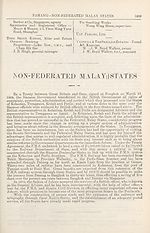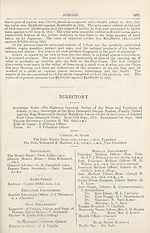1918
(1350) [Page 1270] - Johore
Download files
Complete book:
Individual page:
Thumbnail gallery: Grid view | List view
![(1350) [Page 1270] - Johore](https://deriv.nls.uk/dcn17/1949/1088/194910882.17.jpg)
JOHORE
This State occupies the southern portion of the Malayan Peninsula, and has an area
of about 7,500 square miles. The State is ruled by a Sultan, who is independent, but
under the protection of the British Government so far as external policy is concerned.
The present Sultan, Ibrahim, was born in 1873, and succeeded his father, the late
Sultan Abubakar, in 1895, being crowned on the 2nd of November of that year. On
the 1st January, 1916, the dignity of an Honorary Knight Grand Gross of the
most Distinguished Order of St. Michael and St. George was conferred on
His Highness the Sultan by His Majesty the King, and the investiture took
place at Johore Bahru on May 11, 1916. Since 1910, the Sultan has had the
services of an officer of the Straits or F.M.S. Civil Services as General Adviser, and
other members of these services are seconded to control various departments, with the
result that the government is now on a better footing and the finances materially
improved. The country has made great progress in material prosperity, and its
orderly condition has attracted a good deal of European capital, invested in planting
enterprises.
The revenue for 1916 amounted to $7,976,862 against $5,790,393 in 1915, and the
expenditure to $4,602,433 in 1916 against $3,645,421 in 1915. Improved methods of
collection and administration, and the expansion of agricultural and the tin mining
industries are factors in the increase of revenue. The public debt is now $4,000,000,
representing the balance of the loan incurred to construct and equip. the State
Railway. The railway, which connects Singapore with the F.M.S. system, was
completed in 1909, and its construction has already given a great impetus to the
opening up of this fertile State. Along its 120 miles it provides access to the extensive
areas of valuable forest land not conveniently reached by the natural waterways. It
is operated and leased by the F.M.S. Railway Department, which now controls the
whole of the railways in the Malay Peninsula. The State owns a light railway in
Muar; it carried 418,047 passengers in 1916 and 7,600 tons of goods, and the receipts
were $100,228 compared with $86,701 in 1915.
Eighty-one schools are maintained by the Government, and at five of these English
is taught.
The capital is the town of Johore Bahru, or new Johore, as distinguished from
Johore Lama, or old Johore, the former seat of the Sultans of Johore, which was
situated a few miles up the wide estuary of the Johore river. The new town is a
flourishing little place on the nearest point of the mainland to Singapore island, and
lying about 14 miles to the north-east of Singapore city, in 1° 26' N. It contains
some 10,000 inhabitants, mostly Chinese. Amongst the Government buildings are the
Istana, court and police stations, barracks, gaol, hospital, market, railway station
and a mosque. A plentiful supply of water has been provided since March, 1890. Good,
roads are being made, and public works, such as the construction of waterworks and
bridges and the establishment of an electric light and power station at Johore Bahru, are
receiving a good deal of attention. The Public Works Department spent $1,521,592-
in 1916.
The population of the State at the census in 1911 was ascertained to be 180,412, of
whom 161 were British, 71,315 Malays, 63,405 Chinese, 30,904 Javanese, and 5,659 Indians.
The Chinese are chiefly found as cultivators of gambier and pepper, and are spread over
the range of country in the extreme southern end of the peninsula, nearest to Singapore,
but there is also a large Chinese population on the Jemaluang tin-field near Mersing.
Appended, is a comparison of the exports and imports for the past two years :—
1915 1916
Imports $ 9,163,665 $12,739,747
Exports 28,917,800 41,825,980
Total 4 38,081,465 $54,565,727
European pioneers have, in the last few years, taken up large areas for planting,,
chiefly rubber and coconuts. Gambier and pepper cultivation is on the decline;.
This State occupies the southern portion of the Malayan Peninsula, and has an area
of about 7,500 square miles. The State is ruled by a Sultan, who is independent, but
under the protection of the British Government so far as external policy is concerned.
The present Sultan, Ibrahim, was born in 1873, and succeeded his father, the late
Sultan Abubakar, in 1895, being crowned on the 2nd of November of that year. On
the 1st January, 1916, the dignity of an Honorary Knight Grand Gross of the
most Distinguished Order of St. Michael and St. George was conferred on
His Highness the Sultan by His Majesty the King, and the investiture took
place at Johore Bahru on May 11, 1916. Since 1910, the Sultan has had the
services of an officer of the Straits or F.M.S. Civil Services as General Adviser, and
other members of these services are seconded to control various departments, with the
result that the government is now on a better footing and the finances materially
improved. The country has made great progress in material prosperity, and its
orderly condition has attracted a good deal of European capital, invested in planting
enterprises.
The revenue for 1916 amounted to $7,976,862 against $5,790,393 in 1915, and the
expenditure to $4,602,433 in 1916 against $3,645,421 in 1915. Improved methods of
collection and administration, and the expansion of agricultural and the tin mining
industries are factors in the increase of revenue. The public debt is now $4,000,000,
representing the balance of the loan incurred to construct and equip. the State
Railway. The railway, which connects Singapore with the F.M.S. system, was
completed in 1909, and its construction has already given a great impetus to the
opening up of this fertile State. Along its 120 miles it provides access to the extensive
areas of valuable forest land not conveniently reached by the natural waterways. It
is operated and leased by the F.M.S. Railway Department, which now controls the
whole of the railways in the Malay Peninsula. The State owns a light railway in
Muar; it carried 418,047 passengers in 1916 and 7,600 tons of goods, and the receipts
were $100,228 compared with $86,701 in 1915.
Eighty-one schools are maintained by the Government, and at five of these English
is taught.
The capital is the town of Johore Bahru, or new Johore, as distinguished from
Johore Lama, or old Johore, the former seat of the Sultans of Johore, which was
situated a few miles up the wide estuary of the Johore river. The new town is a
flourishing little place on the nearest point of the mainland to Singapore island, and
lying about 14 miles to the north-east of Singapore city, in 1° 26' N. It contains
some 10,000 inhabitants, mostly Chinese. Amongst the Government buildings are the
Istana, court and police stations, barracks, gaol, hospital, market, railway station
and a mosque. A plentiful supply of water has been provided since March, 1890. Good,
roads are being made, and public works, such as the construction of waterworks and
bridges and the establishment of an electric light and power station at Johore Bahru, are
receiving a good deal of attention. The Public Works Department spent $1,521,592-
in 1916.
The population of the State at the census in 1911 was ascertained to be 180,412, of
whom 161 were British, 71,315 Malays, 63,405 Chinese, 30,904 Javanese, and 5,659 Indians.
The Chinese are chiefly found as cultivators of gambier and pepper, and are spread over
the range of country in the extreme southern end of the peninsula, nearest to Singapore,
but there is also a large Chinese population on the Jemaluang tin-field near Mersing.
Appended, is a comparison of the exports and imports for the past two years :—
1915 1916
Imports $ 9,163,665 $12,739,747
Exports 28,917,800 41,825,980
Total 4 38,081,465 $54,565,727
European pioneers have, in the last few years, taken up large areas for planting,,
chiefly rubber and coconuts. Gambier and pepper cultivation is on the decline;.
Set display mode to:
![]() Universal Viewer |
Universal Viewer | ![]() Mirador |
Large image | Transcription
Mirador |
Large image | Transcription
Images and transcriptions on this page, including medium image downloads, may be used under the Creative Commons Attribution 4.0 International Licence unless otherwise stated. ![]()
| Asian directories and chronicles > 1918 > (1350) [Page 1270] - Johore |
|---|
| Permanent URL | https://digital.nls.uk/194910880 |
|---|
| Attribution and copyright: |
|
|---|---|
| Description | Volumes from the Asian 'Directory and Chronicle' series covering 1917-1941, but missing 1919 and 1923. Compiled annually from a multiplicity of local sources and research. They provide listings of each country's active corporations, foreign residents and government agencies of all nationalities for that year, together with their addresses. Content includes: various treaties; coverage of conflicts; currencies and taxes; consular fees; weights and measures; public holidays; festivals and traditions. A source of information for both Western states and communities of foreigners living in Asia. Published by Hongkong Daily Press. |
|---|---|
| Shelfmark | H3.86.1303 |
| Additional NLS resources: |

